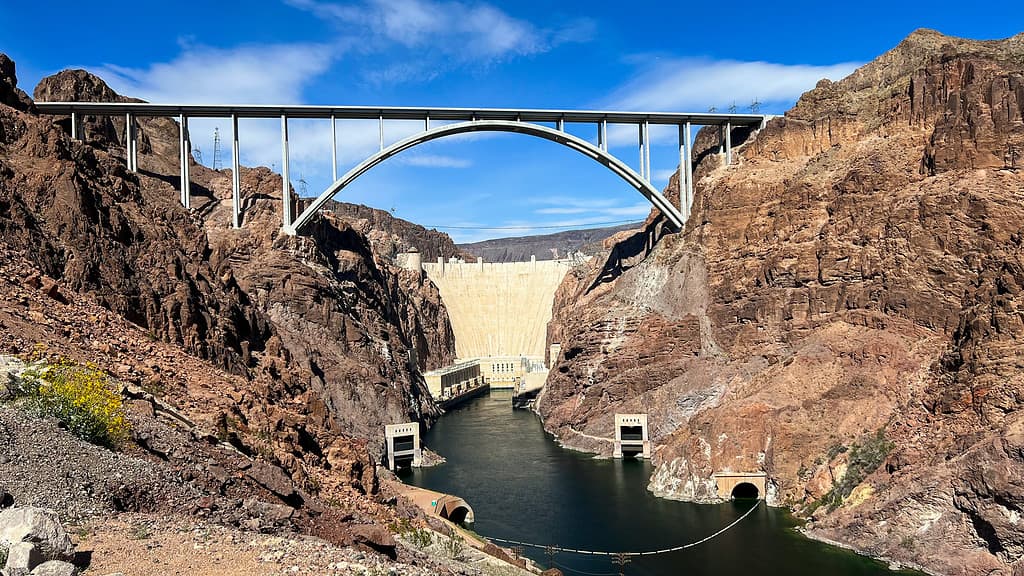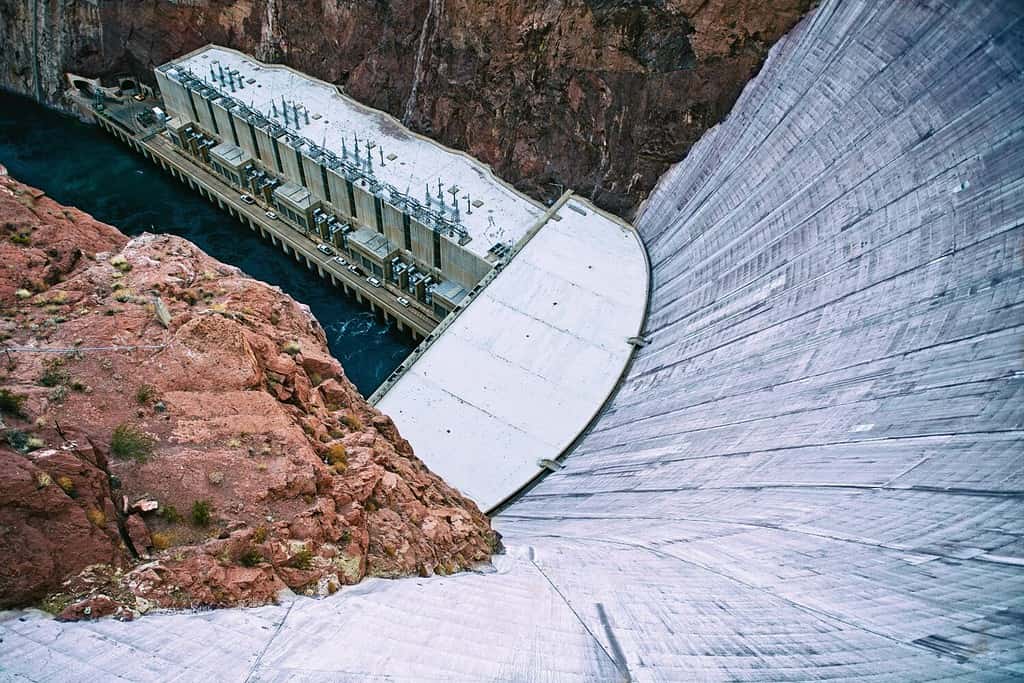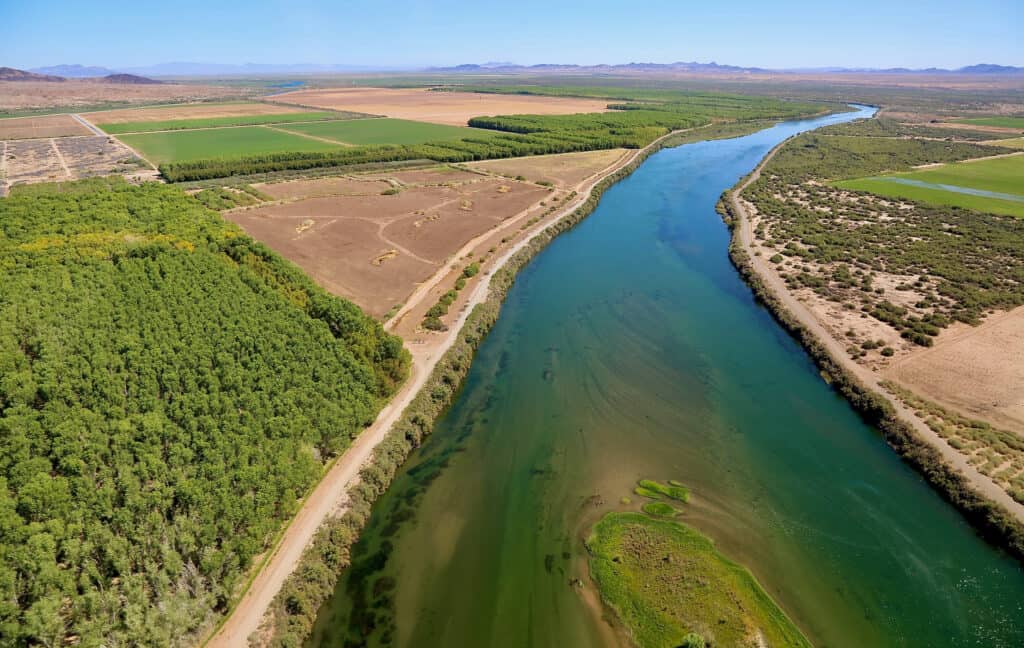Hoover Dam is an engineering marvel. At nearly 100 years old, it continues to operate as designed and produces water and electricity for nearby states. But there’s a strange rumor that something is wrong with the gravity at Hoover Dam. In fact, some people say there are places where there is no gravity at all. They report water behaves strangely, pouring “up” instead of “down” as we would normally expect. How could this be possible?
Does it have something to do with the massive size of the dam or its building materials? Is it haunted by some of the people whose graves were flooded when the reservoir was filled? Or maybe spooked by those who died in the building of the dam? Was there some reverse-engineered alien technology involved? Not quite. The answer is simple and straightforward, but that doesn’t make the effect any less remarkable. Read on to find out why there seems to be “no gravity” at Hoover Dam.
Facinating Facts About the Hoover Dam
- Hoover Dam was built during the Great Depression and named after President Herbert Hoover.
- Its building was exorbitantly expensive at the time. However, in the almost 100 years since, it has generated enough electricity to pay for its own construction.
- Hoover Dam was built on the Colorado River at the border between Nevada and Arizona.
- It supplies electricity and water to both states as well as California.
- Its reservoir, Lake Mead, is drying up due to drought and the growing population in the west.
- The construction method causes powerful updrafts of wind that make spilled water appear to defy gravity.
- The dam and reservoir have altered the ecology of the region, not always in a beneficial way.
- There are a lot of recreation opportunities at the dam and in nearby Las Vegas.

Hoover Dam
©Doug Michaels/iStock via Getty Images
Hoover Dam Basics
Hoover Dam is located on the Colorado River at the border of Arizona and New Mexico. It was built from 1931-1936. It is one of the largest dams in the U.S., at 1,244 feet long, 726 feet tall, and 660 feet wide. This makes the base almost as wide as the length of two football fields! It was named after President Herbert Hoover, who served from 1929-1933 and played an important part in completing the project during the Great Depression. Nearly 100 people died in the building of Hoover Dam, but in the difficult economic conditions people lived in at that time, thousands eagerly took jobs on this construction project, despite the dangers.
Building Hoover Dam cost $49 million, which is equivalent to $760 million today. Another $71 million was spent on the power plant and generators. This has been a good investment though. Over the century the dam has been in operation, it has generated enough electricity to pay back the cost of its own construction.

The Colorado River was unpredictable until Hoover Dam and Lake Mead were built and regulated its flow.
©iStock.com/Beth Ruggiero-York
Electricity and Water from Hoover Dam
Hoover Dam releases 20,000 gallons of water per second to run its 17 electric turbines. This creates a magnetic field that produces enormous amounts of electricity: four billion kilowatt-hours to supply the needs of over one million people in three states. About half of it goes to customers in California and the remainder goes to Nevada and Arizona.
When full, Lake Mead is 112 miles long and 532 feet deep, with a capacity of 28.23 million acre-feet of water. Currently, though, it is only 30% full due to the growing population of the region and several years of drought. The situation is getting desperate enough that some people are calling for radical solutions, such as piping water from the Mississippi River 1,000 miles west over the Rocky Mountains to replenish the reservoir. However, there are many reasons why this is a pretty bad idea.

Hoover Dam and Lake Mead keep the lights on and the fountains flowing in the desert city of Las Vegas.
©iStock.com/RandyAndy101
An “Anti-Gravity” Construction Trick
So, what’s this business about Hoover Dam having no gravity? And if that’s the case, why don’t people nearby float off into space? The reality is not so dramatic, but it’s cool, nonetheless. When you stand at the top of the dam on the side facing downstream and pour out a bottle of water, it will float up instead of down. The reason for this strange act is not that gravity turns “off” there, but that windspeed turns “up.” The bowlike shape of the massive dam channels the wind, hitting the dam straight up and causing the water to spill “up” instead of “down.”
The reason for this is the way the dam is constructed. Just as the Romans used arches as powerful supports for bridges, aqueducts, temples, and other large projects, the builders of Hoover Dam used an arch-like shape turned on its side, as a weight-bearing design element of Hoover Dam. Instead of being built as a straight line, the dam curves back into the lake in a bow shape.
Not only does this channel and focus air upward but the tremendous weight and pressure from the water of the reservoir are carried by this construction to its sides, where it is transferred into the solid rock of the canyon walls on either side. This creates such a powerful and stable structure that engineers predict it can last up to 10,000 years. Who knows, if our civilization collapses, Hoover Dam might be one of the last physical traces of it left far into the future, much like the pyramids of Egypt.

The curved shape of Hoover Dam makes it tremendously strong but also channels wind upward.
©Michal Plachy/Shutterstock.com
How Hoover Dam Does Change Nature
Even though Hoover Dam doesn’t actually affect gravity, it has affected nature in other ways. Damming up the Colorado River changed its natural cycles of flooding and drought, which local plants and animals had adapted to. The river’s delta region, where it flows into the Gulf of California in Mexico, was greatly damaged in the first six years after the dam was built and Lake Mead was filling up. Populations of indigenous plants and fish were greatly reduced, and non-native species were introduced into the lake. Now, four indigenous fish species are endangered. These are the bonytail chub, Colorado pikeminnow, humpback chub, and razorback sucker.

Hoover Dam provides flood control for the Colorado River but has disrupted several species.
©iStock.com/Chris Szwedo
What Can You Do at Hoover Dam and Lake Mead?
Hoover Dam and Lake Mead are popular attractions for locals and visitors ready to get out of the city and do something outdoors. Approximately one million visitors find their way there every year. The Lake Mead National Recreation Area includes the dam and reservoir. It’s a good place for camping, hiking, hunting, or fishing. You can also go on a dam tour, where you’ll be able to see art-deco art and architecture and tunnels from the original construction.
There’s a viewing platform where you can get spectacular photos of the lake, the dam, and the gorge below. And while you’re doing those gravity-defying magic tricks with a bottle of water, try spilling some on the sidewalk away from the wind and watching how startlingly fast it evaporates in the arid climate. If you liked that trick, make the 40-mile drive to Las Vegas and watch your money do the same thing!
The photo featured at the top of this post is © Doug Michaels/iStock via Getty Images
Thank you for reading! Have some feedback for us? Contact the AZ Animals editorial team.






